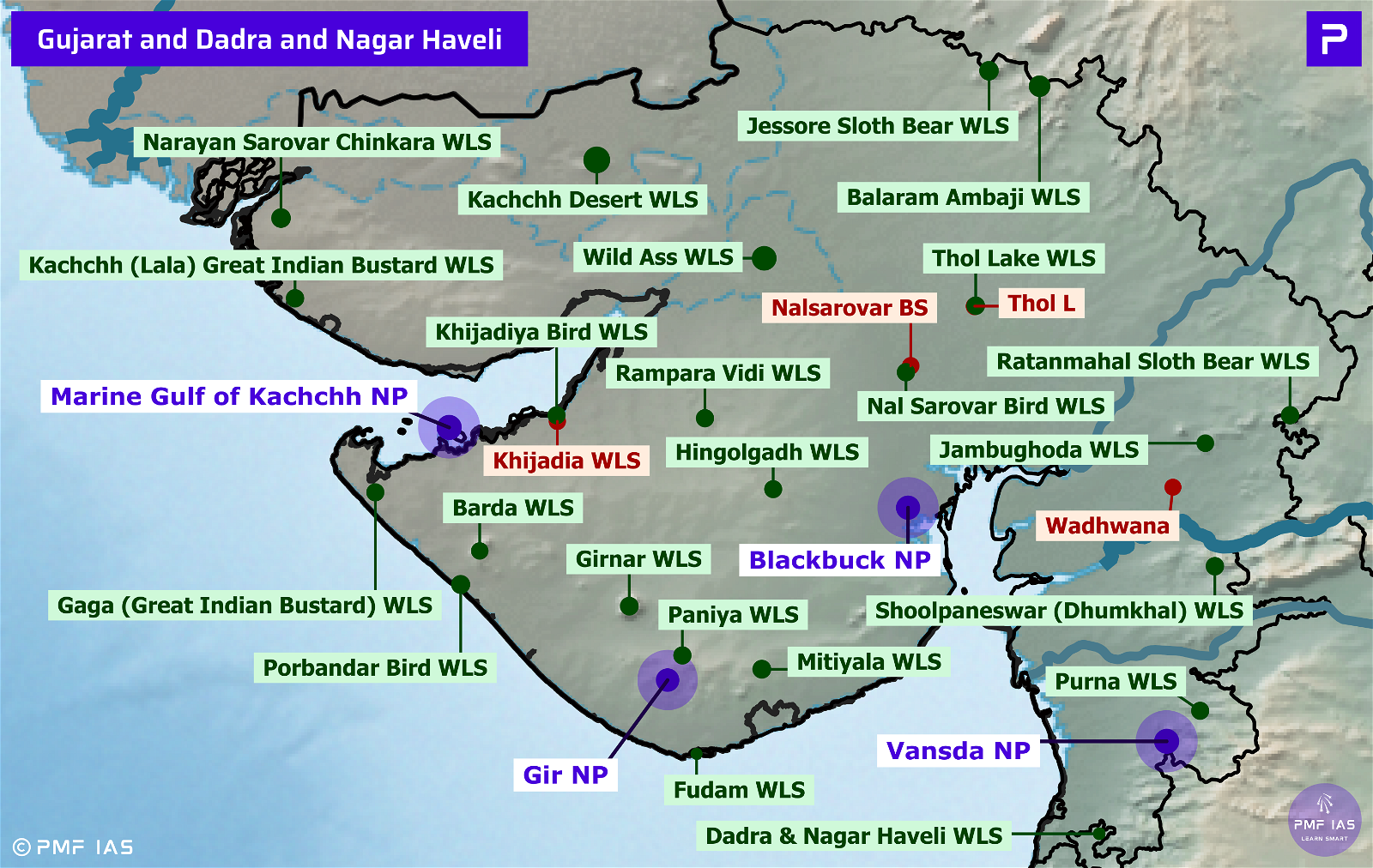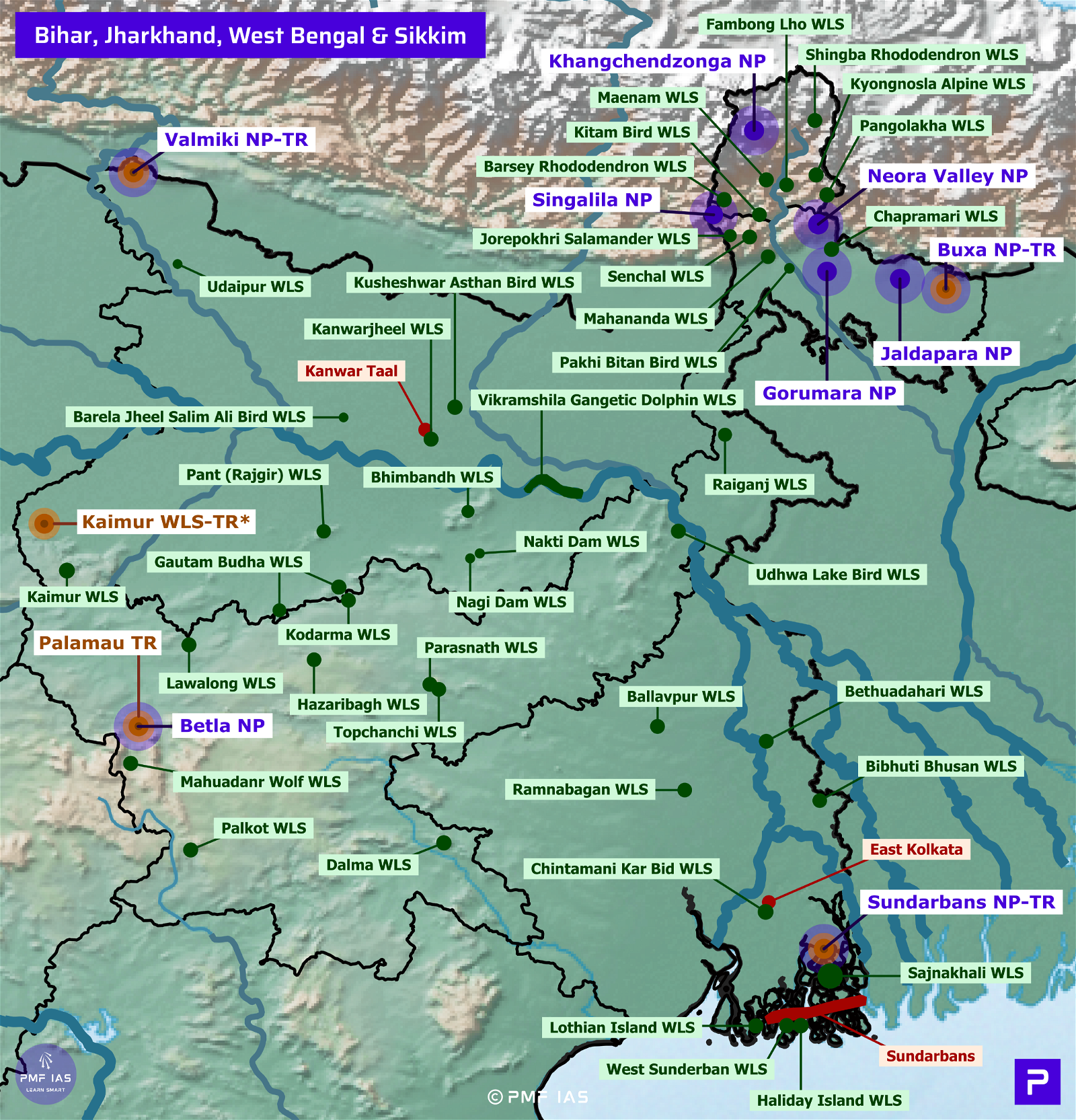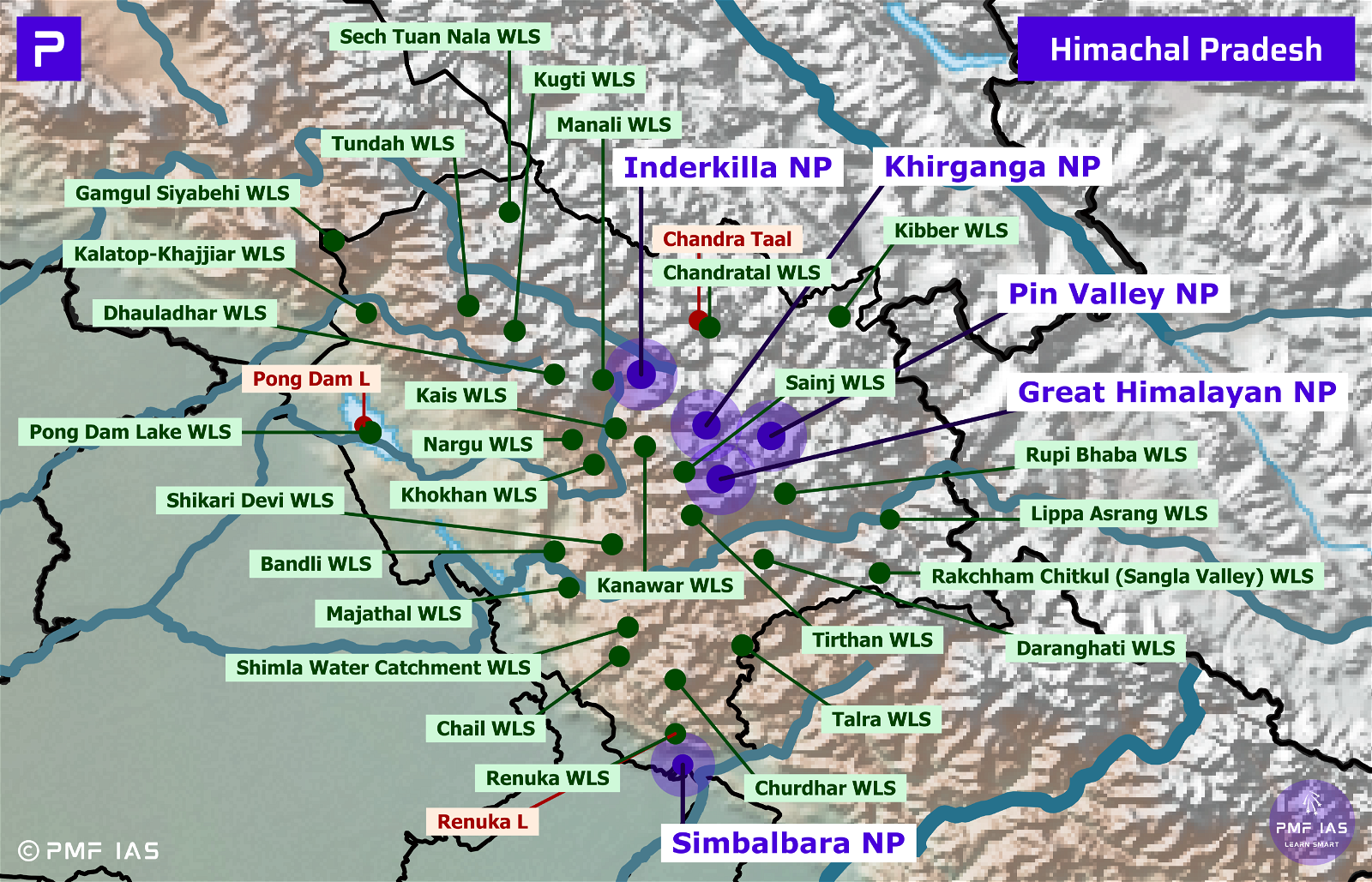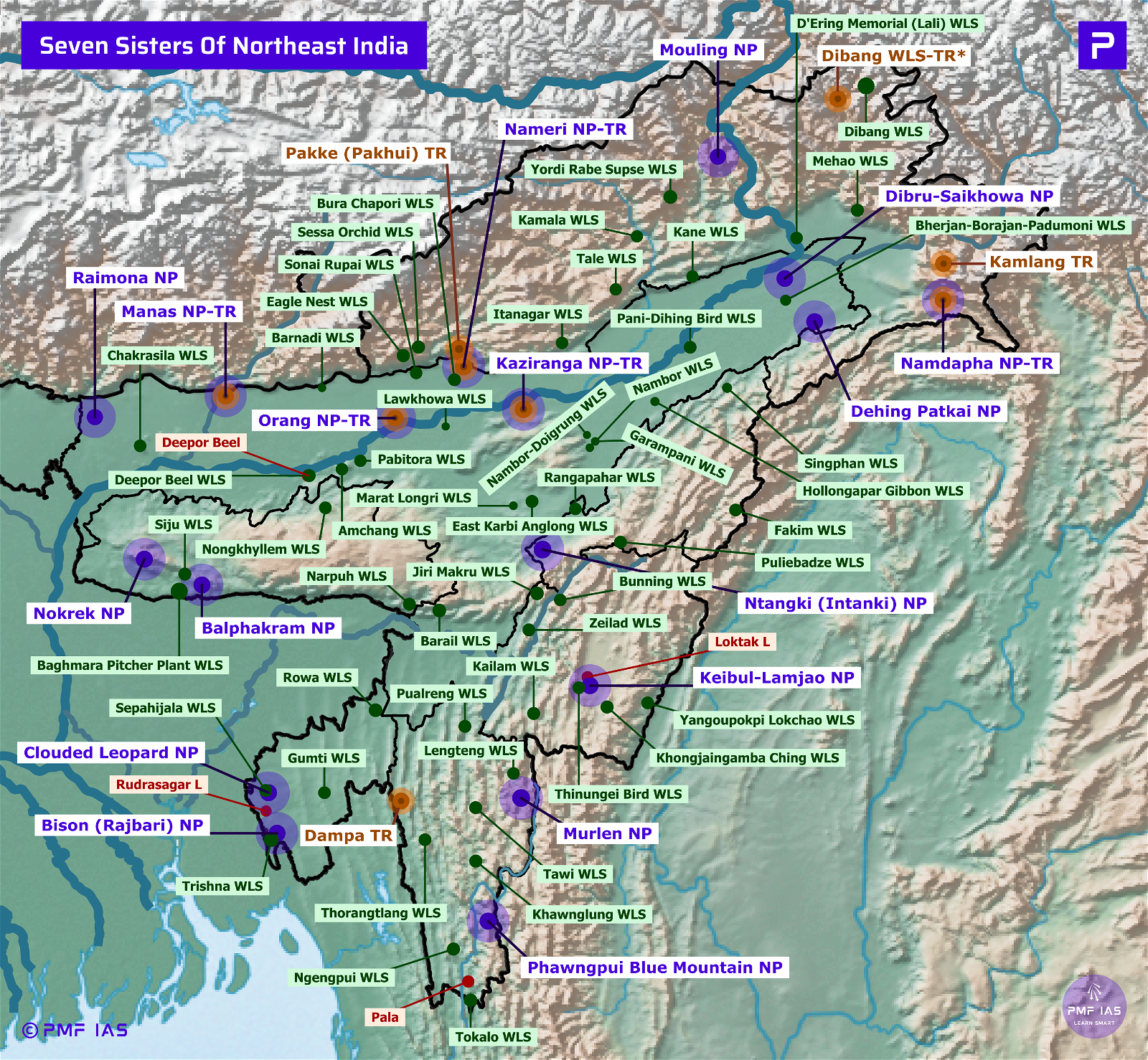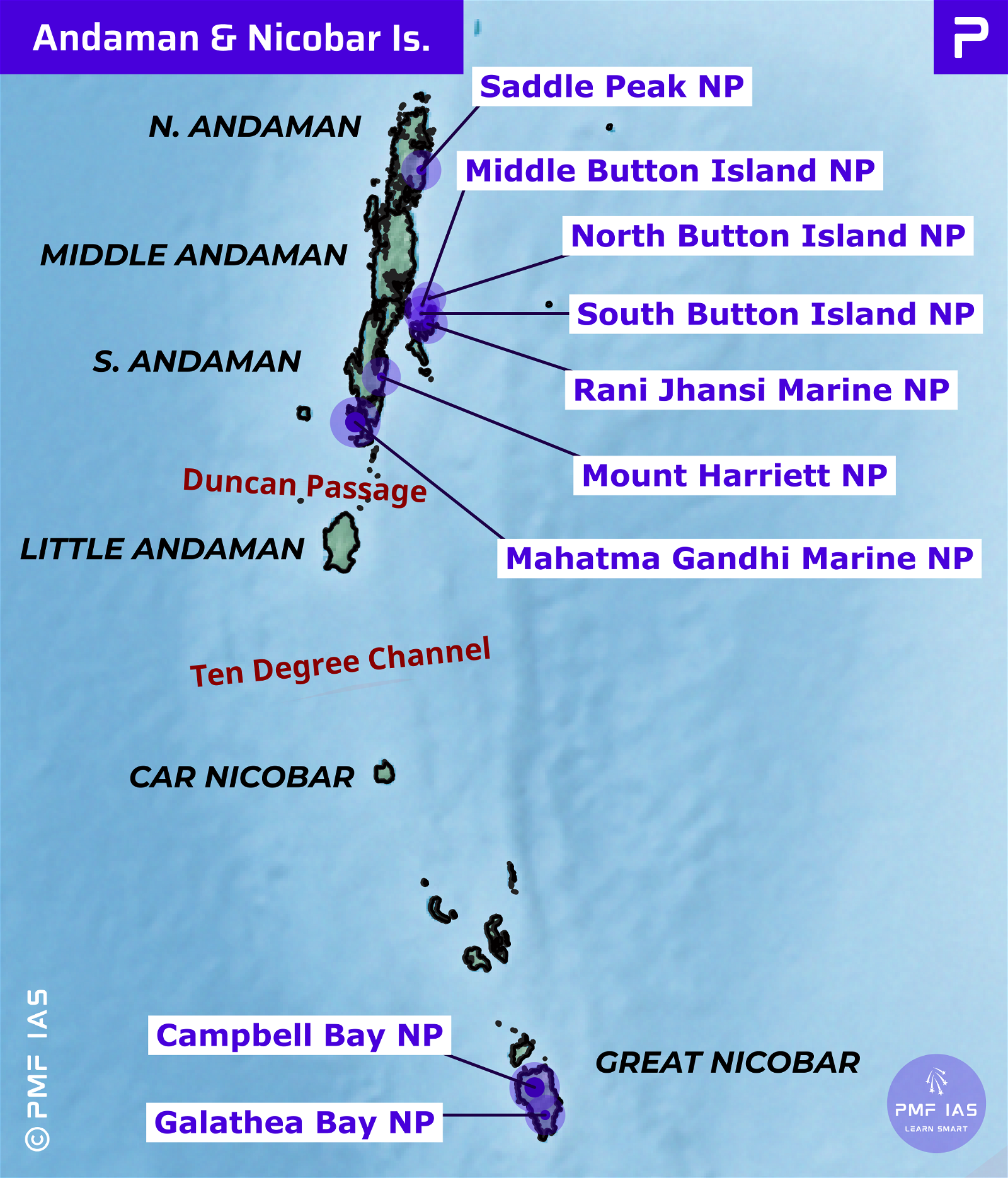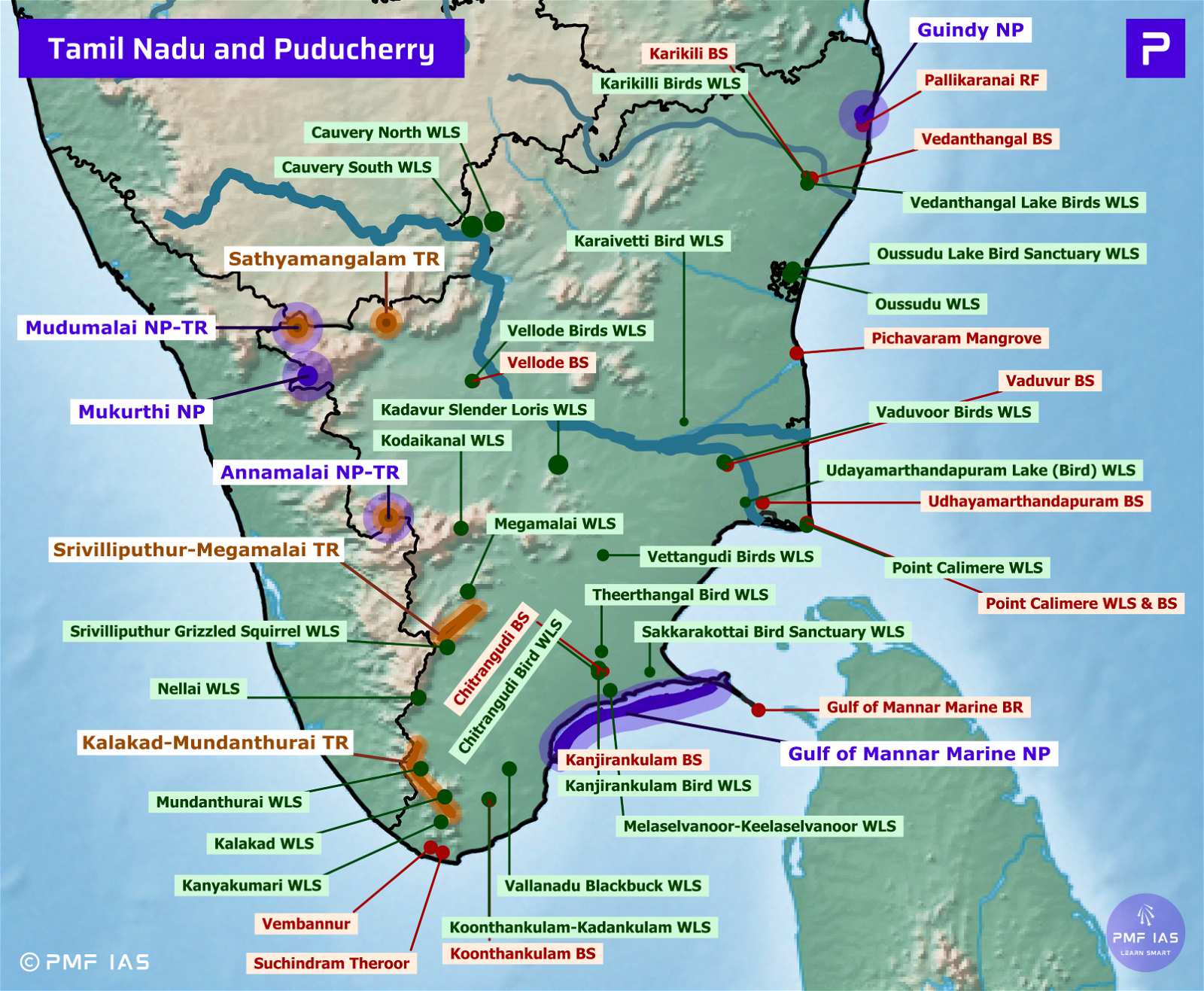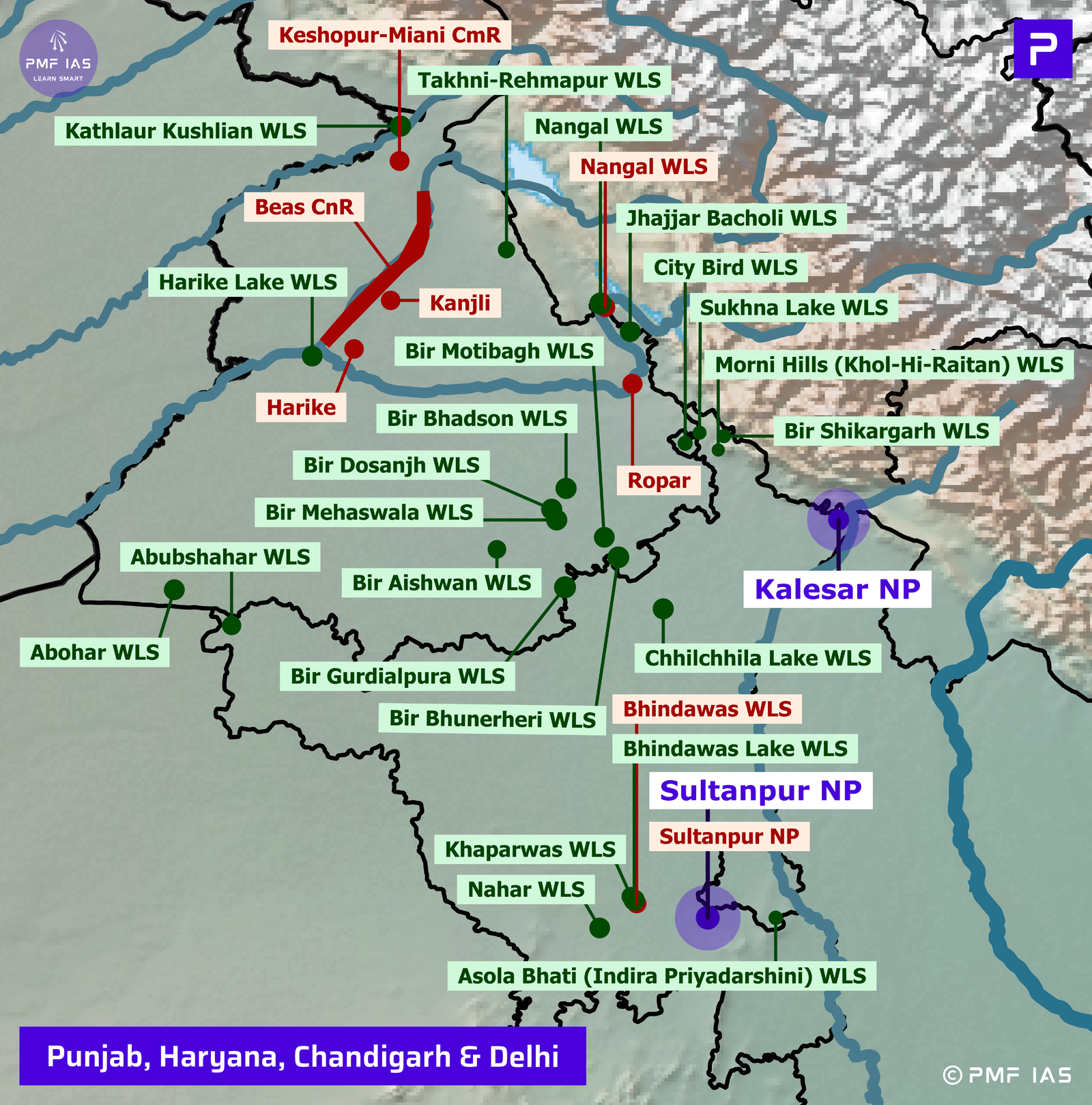
Uttar Pradesh National Parks, Tiger Reserves, Wildlife Sanctuaries & Ramsar Sites
Subscribe to Never Miss an Important Update! Assured Discounts on New Products!
Must Join PMF IAS Telegram Channel & PMF IAS History Telegram Channel
Last updated on April 25, 2024 2:22 AM
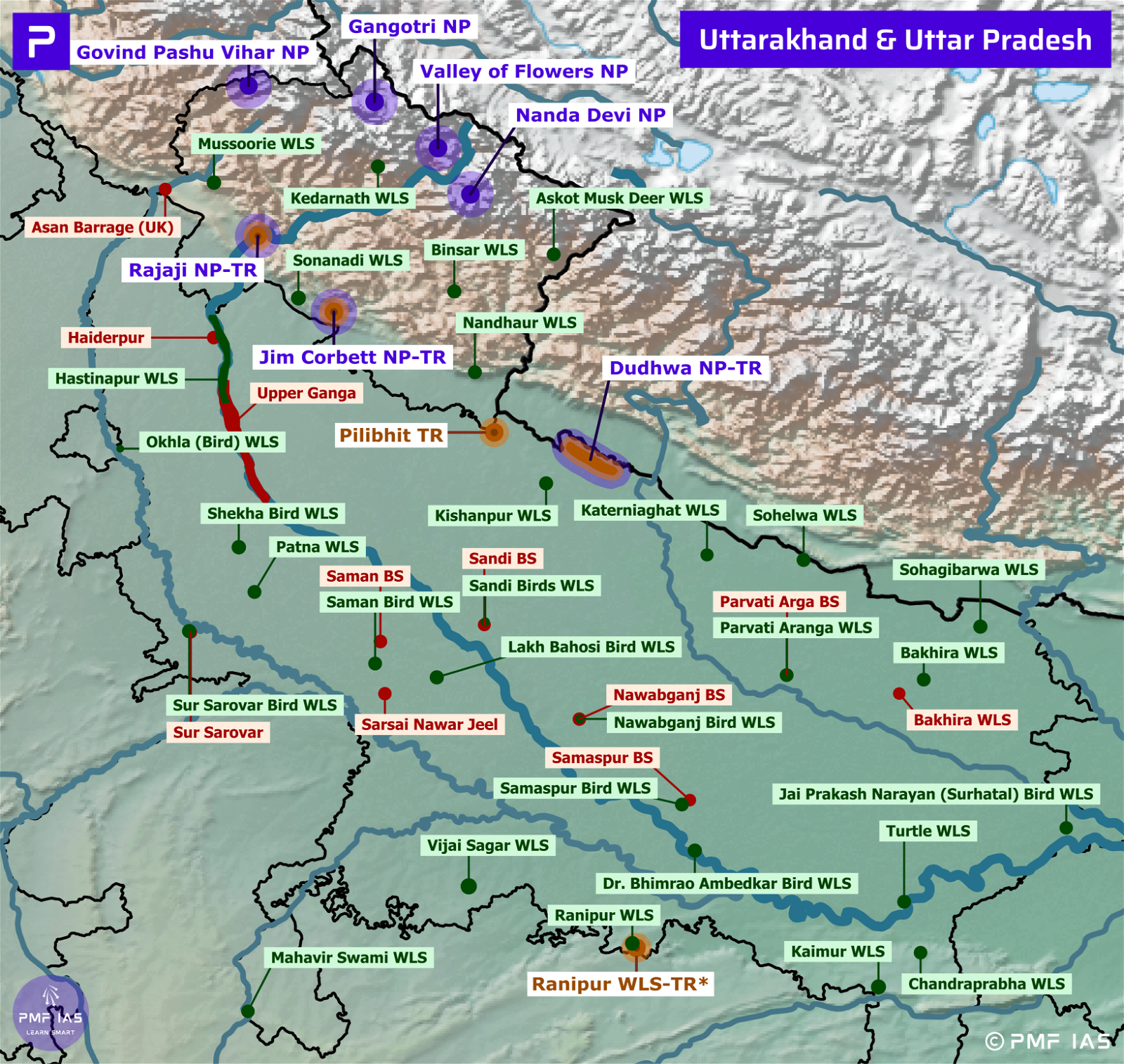
Amangarh Tiger Reserve (buffer of Jim Corbett Tiger Reserve)
- It forms an extension of and buffer to Jim Corbett National Park.
- After the state of Uttarakhand was carved out of Uttar Pradesh, Jim Corbett went to Uttarakhand and Amangarh remained in Uttar Pradesh.
Dudhwa Tiger Reserve, National Park
- It is located in the Terai belt (Indo-Nepal border).
- Dudhwa Tiger Reserve = Dudhwa National Park + Kishanpur Wildlife Sanctuary + Katarniaghat Wildlife Sanctuary.
- The Sharda River (Kali or Mahakali River) separates Dudhwa National Park from Kishanpur Wildlife Sanctuary. The Ghaghara River separates Dudhwa National Park from Katarniaghat Wildlife Sanctuary.
- Indian rhinoceros (VU) was reintroduced into Dudhwa from Pobitora Sanctuary (Assam).
- Major Fauna: Swamp deer (barasingha), sambar deer, barking deer, hog deer, tiger, rhinoceros, elephants.
- Black-crested bulbul (LC) was spotted after several years.
Pilibhit Tiger Reserve
- It lies in the Terai belt (in the Indo-Nepal border).
- The Sharda Sagar Dam is on the east and River Sharda (a tributary of River Ghaghara) is on the northeast.
- Vegetation: Sal forests, tall grasslands and swamps characterized by periodic flooding.
- Major Fauna: Bengal tiger, leopard, swamp deer, hog deer, blackbuck, sambar, rhesus macaque, gharial.
Ranipur Tiger Reserve, Wildlife Sanctuary
- Uttar Pradesh approved the state’s 4th Tiger Reserve in the Ranipur Wildlife Sanctuary . It will be the 1st Tiger Reserve in the UP’s Bundelkhand region and the 54th TR in India.
- Flora: tropical dry deciduous forests.
- Fauna: Tigers, leopards, spotted deer, sambhar, chinkara.
- Ranipur Wildlife Sanctuary has no tigers of its own, but it is frequented by tigers from the nearby Panna Tiger Reserve. Ranipur Wildlife Sanctuary is an important corridor for the movement of tigers.
Wildlife Sanctuaries of Uttar Pradesh
Bakhira Wildlife Sanctuary
- It is a natural flood plain wetland located in Sant Kabir Nagar district. The Rapti River flows through it. It provides a wintering ground for a number of migratory birds.
Chandraprabha Wildlife Sanctuary
- It spreads over the hillocks on the north slope of the Kaimur Range between the Ganges and Son rivers.
Hastinapur Wildlife Sanctuary
- It covers Meerut, Muzzafarnagar, Bijnor and Meerut districts. It lies on the western bank of the Ganges River.
- Major Fauna: Swamp deer (VU), smooth-coated otter (VU), Ganges river dolphin (EN), gharials (CR).
Jai Prakash Narayan (Surhatal) Bird Wildlife Sanctuary
- It is a wetland located near the confluence of Ghaghara and Ganges Rivers.
Kaimur Wildlife Sanctuary
- It is located in Sonbhadra and Mirzapur districts. It is contiguous with the Chandraprabha Wildlife Sanctuary of UP and Kaimur Wildlife Sanctuary of Bihar. The extends along the Kaimur Range. It extends to the Son River on the east, and to the border of Madhya Pradesh on the west.
- It is an important tiger and elephant corridor.
Katerniaghat Wildlife Sanctuary
- It is a located in the Upper Gangetic terai plain of Bahraich. It provides connectivity between tiger habitats of Dudhwa National Park (Uttar Pradesh) and Bardia National Park (Nepal).
- Dudhwa Tiger Reserve = Katerniaghat Wildlife Sanctuary + Kishanpur Wildlife Sanctuary + Dudhwa National Park. Ghaghara River separates Dudhwa National Park from Katerniaghat Wildlife Sanctuary.
- Major fauna: Tigers, gharials (CR), mugger or marsh crocodile (VU).
- Girwa River in the Wildlife Sanctuary is natural habitat for gharials where they sympatric with the muggers.
Kishanpur Wildlife Sanctuary
- It is contiguous with the Pilibhit Tiger Reserve. The Sarda River (known as Kali River before it reaches the plains; it flows along the Indo-Nepal Border) separates Kishanpur Wildlife Sanctuary from the Dudhwa National Park.
- Major Fauna: Swamp deer (VU), Bengal florican (CR), Lesser Florican (CR).
Mahavir Swami Wildlife Sanctuary
- It is located along MP-UP border. It lies on the bank of Betwa River (a tributary of Yamuna) near Rajghat Reservoir.
National Chambal Gharial Wildlife Sanctuary
- It is located on the Chambal River near the tripoint of Rajasthan, Madhya Pradesh and Uttar Pradesh.
Nawabganj Bird Wildlife Sanctuary (Ramsar Site)
- It is also known as Shahid Chandra Shekhar Azad Bird Sanctuary. It is located in Unnao district on the Kanpur-Lucknow highway.
Okhala Bird Wildlife Sanctuary
- It is a wetland located at the Okhla barrage over Yamuna River in Noida, Gautam Buddh Nagar district, on the Delhi-UP border. It is formed by the creation of Okhla Barrage.
Parvati Aranga Wildlife Sanctuary (Ramsar Site)
- It is an ox-bow lake formed by the Ghaghara River.
Saman Bird Wildlife Sanctuary (Ramsar Site)
- It is a seasonal oxbow lake on the Ganges floodplain.
Samaspur Bird Wildlife Sanctuary (Ramsar Site)
- It is a perennial lowland marsh in Rae Bareli district.
Sandi Birds Wildlife Sanctuary (Ramsar Site)
- It is a freshwater marsh designated as an Important Bird Area by BirdLife International.
Shekha Bird Wildlife Sanctuary
- It located near Aligarh. It is a perennial lake that came into existence after the formation of the Upper Ganges Canal.
Sur Sarovar Bird Wildlife Sanctuary
- It is located on the right bank of Yamuna River near Agra.
Others
- Dr. Bhimrao Ambedkar Bird Wildlife Sanctuary: Pratapgarh district.
- Lakh Bahosi Bird Wildlife Sanctuary: Kannauj district.
- Patna Wildlife Sanctuary: north-east of Agra in Etah district.
- Ranipur Wildlife Sanctuary: Chitrakoot district.
- Sohagibarwa Wildlife Sanctuary: located on the bank of the Gandak River in the Maharajganj district.
- Sohelwa Wildlife Sanctuary: located along the Shivalik hills.
- Turtle Wildlife Sanctuary: Varanasi district.
- Vijai Sagar Wildlife Sanctuary: Mahoba District.
Ramsar Sites of Uttar Pradesh (10)
Bakhira WLS
- This freshwater marsh is situated near Gorakhpur.
- Avifauna: Egyptian Vultures (EN), Greater Spotted Eagle (VU), Common Pochard (VU), Swamp Francolin (VU)
Haiderpur Wetland
- It is a wetland in Hastinapur WLS formed by the construction of the Madhya Ganga Barrage.
- Endangered Fauna: Gharial (CR), Golden Mahseer (EN), Hog Deer (EN), Swamp Deer (VU).
Nawabganj BS
- It is a shallow marshland near Lucknow. It was renamed Chandra Shekhar Azad BS.
- Endangered Avifauna: Egyptian Vulture (EN), Pallas’s Fish Eagle (EN), Lesser Adjutant (VU)
Parvati Arga BS
- It is a permanent freshwater environment consisting of two oxbow lakes.
- Avifauna: Red-Headed Vulture (CR), White-Rumped Vulture (CR), Indian Vulture (CR)
Saman BS
- It is a seasonal oxbow lake on the Ganges floodplain.
- Avifauna: Sarus Crane (VU), Greater Spotted Eagle (VU)
Samaspur BS
- It is a perennial marsh typical of the Indo-Gangetic Plains.
- Avifauna: Egyptian Vulture (EN), Pallas’s Fish Eagle (EN).
Sandi BS
- Endangered Avifauna: Sarus Crane (VU)
Sarsai Nawar Jheel (IBA)
- It is a marsh. Its name is derived from the large non-migratory Sarus Crane (VU). The nearby Hajari Mahadev temple is visited by thousands of pilgrims each year.
- Endangered Avifauna: White-Rumped Vulture (CR)
Sur Sarovar (Keetham Lake)
- It was created to supply water to the city of Agra.
- Endangered Avifauna: Greater Spotted Eagle (VU), Catfish (Wallago attu – VU)
Upper Ganga River
- It stretches from Brijghat to Narora. Fauna: Ganges River Dolphin (EN), Gharial (Fish-Eating Crocodile – CR)
Last updated on April 25, 2024 2:22 AM






